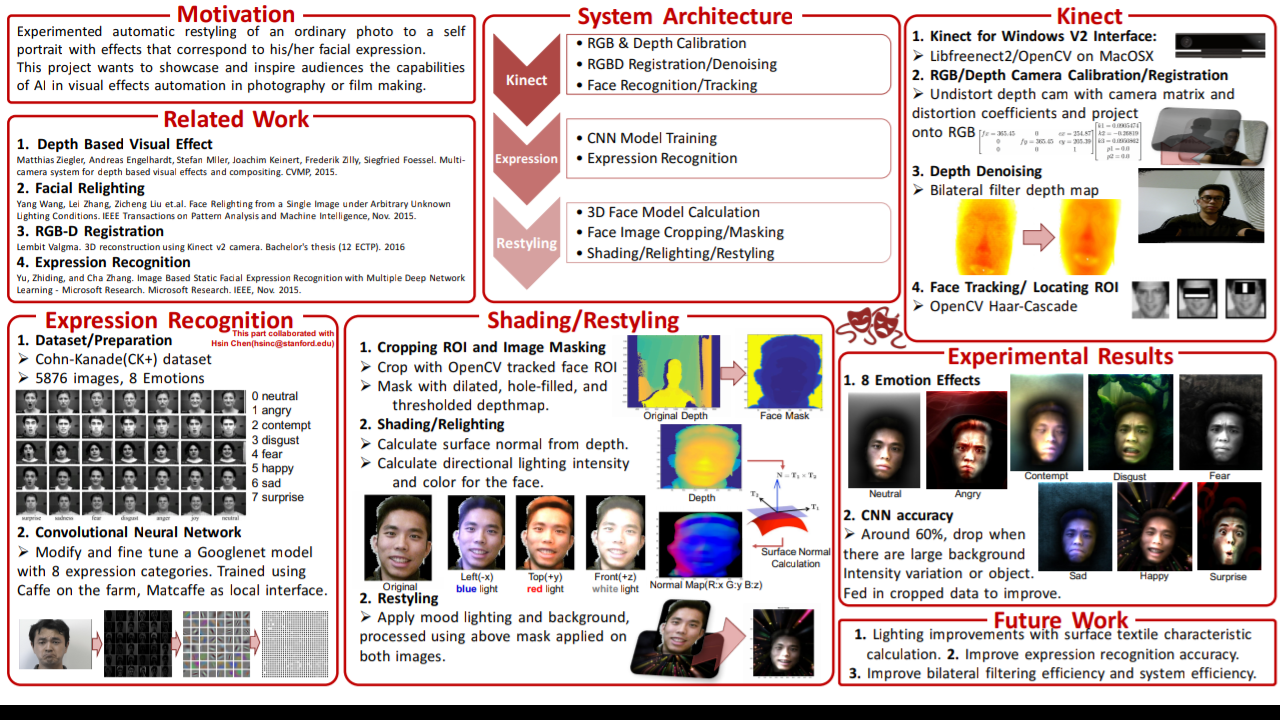Automated Restyling of Human Portrait Based on Facial Expression Recognition and 3D Reconstruction
Automated Restyling of Human Portrait Based on Facial Expression Recognition and 3D Reconstruction
OUTPUT
1.1 Depth Data Acquisition
We plan to use Microsoft Kinect to capture half body portraits of the user. We use not only color
but depth information for restyling purposes.
1.2 Facial Feature Extraction
With the photos of facial expression collected as our dataset, we then extract the features from them
for later model training. This process can be done in several ways, one involves filtering certain
colors of the pictures to obtain the shape of facial features (such as mouth, eyes, and eyebrows), then
calculating their angle, momentum, or other characteristics. The results can be used as our training
features. Using Scale-invariant feature transform (SIFT) algorithm is another way to collect the
feature descriptions.In this project, We plan to integrate existing approches and develope our own
feature collecting stategy. The relevant research papers are listed below.
1.3 Expression Recognition(CS229)
There are a variety of methods used to achieve the goal of facial expressions recognition, in this
project, we plan to use convolutional neural network as our main approach. We choose CNN for
its great performance shown in existing works [4]. Also, [5] provided a framework of combining
multiple CNN models to boost the facial expression predicting result, and we aim to follow similar
method to seek for further improvements of our model. On top of the techniques above, we found
in [6] a new way to build neural network with a few examples only, and we will try to integrate this
method into our emotion recognition process.
1.4 Portrait Restyling
By utilizing the depth map of the portrait, the system is able to mimic real world lighting condition
instead of a plain filter applied to the image. By structuring different color temperature lighting as
well as partial filters, the system will be able to automatically reconstruct a dramatic portrait from
a plan portrait. As described in [1] and [2], a 3D facial model obtained by Kinect and be used to
calculate rendering of light sources from various directions. Relighting style will be similar to [3]
while incorporating a expression based automatic restyling
References
OUTPUT
1.1 Depth Data Acquisition
We plan to use Microsoft Kinect to capture half body portraits of the user. We use not only color
but depth information for restyling purposes.
1.2 Facial Feature Extraction
With the photos of facial expression collected as our dataset, we then extract the features from them
for later model training. This process can be done in several ways, one involves filtering certain
colors of the pictures to obtain the shape of facial features (such as mouth, eyes, and eyebrows), then
calculating their angle, momentum, or other characteristics. The results can be used as our training
features. Using Scale-invariant feature transform (SIFT) algorithm is another way to collect the
feature descriptions.In this project, We plan to integrate existing approches and develope our own
feature collecting stategy. The relevant research papers are listed below.
1.3 Expression Recognition(CS229)
There are a variety of methods used to achieve the goal of facial expressions recognition, in this
project, we plan to use convolutional neural network as our main approach. We choose CNN for
its great performance shown in existing works [4]. Also, [5] provided a framework of combining
multiple CNN models to boost the facial expression predicting result, and we aim to follow similar
method to seek for further improvements of our model. On top of the techniques above, we found
in [6] a new way to build neural network with a few examples only, and we will try to integrate this
method into our emotion recognition process.
1.4 Portrait Restyling
By utilizing the depth map of the portrait, the system is able to mimic real world lighting condition
instead of a plain filter applied to the image. By structuring different color temperature lighting as
well as partial filters, the system will be able to automatically reconstruct a dramatic portrait from
a plan portrait. As described in [1] and [2], a 3D facial model obtained by Kinect and be used to
calculate rendering of light sources from various directions. Relighting style will be similar to [3]
while incorporating a expression based automatic restyling
References
[1] Yang Wang, Lei Zhang, Zicheng Liu et.al Face Relighting from a Single Image under Ar-
bitrary Unknown Lighting Conditions. IEEE Transactions on Pattern Analysis and Machine
Intelligence ( Volume: 31, Issue: 11, Nov. 2009 )
[2] Zhen Wen, Zicheng Liu, Thomas S. Huang. Face Relighting with Radiance Environment
Maps. CVPR, 2003.
[3] Matthias Ziegler, Andreas Engelhardt, Stefan Mller, Joachim Keinert, Frederik Zilly,
Siegfried Foessel. Multi-camera system for depth based visual effects and compositing
CVMP, 2015.
[4] Fasel, B. Robust Face Analysis Using Convolutional Neural Networks. Object Recognition
Supported by User Interaction for Service Robots (2001): 1-48.
[5] Yu, Zhiding, and Cha Zhang. Image Based Static Facial Expression Recognition with Multiple
Deep Network Learning - Microsoft Research. Microsoft Research. IEEE, Nov. 2015.
[6] Vinyals, Oriol, Blundell, Charles, Lillicrap, Timothy, Kavukcuoglu, Koray, and Wierstra,
Daan. Matching networks for one shot learning. arXiv preprint arXiv:1606.04080, 2016.




Comments
Post a Comment